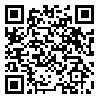Volume 76, Issue 12 (March 2019)
Tehran Univ Med J 2019, 76(12): 799-803 |
Back to browse issues page
Download citation:
BibTeX | RIS | EndNote | Medlars | ProCite | Reference Manager | RefWorks
Send citation to:



BibTeX | RIS | EndNote | Medlars | ProCite | Reference Manager | RefWorks
Send citation to:
Falahati Marvast F, Arabalibeik H, Alipour F, Sheikhtaheri A, Nouri L. A clinical decision support system for contact lens evaluation. Tehran Univ Med J 2019; 76 (12) :799-803
URL: http://tumj.tums.ac.ir/article-1-9416-en.html
URL: http://tumj.tums.ac.ir/article-1-9416-en.html
Fatemeh Falahati Marvast1 
 , Hossein Arabalibeik *
, Hossein Arabalibeik * 
 2, Fatemeh Alipour3
2, Fatemeh Alipour3 
 , Abbas Sheikhtaheri4
, Abbas Sheikhtaheri4 
 , Leila Nouri3
, Leila Nouri3 


 , Hossein Arabalibeik *
, Hossein Arabalibeik * 
 2, Fatemeh Alipour3
2, Fatemeh Alipour3 
 , Abbas Sheikhtaheri4
, Abbas Sheikhtaheri4 
 , Leila Nouri3
, Leila Nouri3 

1- Department of Health Technology, School of Public Health, Shahid Sadoughi University of Medical Sciences, Yazd, Iran.
2- Research Center of Biomedical Technology and Robotics (RCBTR), Tehran University of Medical Sciences, Tehran, Iran. ,arabalibeik@tums.ac.ir
3- Farabi Eye Hospital, Tehran University of Medical Sciences, Tehran, Iran.
4- Department of Health Information Management, School of Health Management and Information Sciences, Iran University of Medical Sciences, Tehran, Iran.
2- Research Center of Biomedical Technology and Robotics (RCBTR), Tehran University of Medical Sciences, Tehran, Iran. ,
3- Farabi Eye Hospital, Tehran University of Medical Sciences, Tehran, Iran.
4- Department of Health Information Management, School of Health Management and Information Sciences, Iran University of Medical Sciences, Tehran, Iran.
Abstract: (3165 Views)
Background: Contact lenses are transparent, thin plastic disks that cover the surface of the cornea. Appropriate lens prescription should be performed properly by an expert to provide better visual acuity and reduce side effects. The lens administration is a multi-stage, complex and time-consuming process involving many considerations. The purpose of this study was to develop a decision support system in the field of contact lens prescription.
Methods: In this fundamental study, data were collected from 127 keratoconus patients referred to the contact lens clinic at Farabi Eye Hospital, Tehran, Iran during the period of March 2013 to July 2014. Five parameters in the contact lens prescribing process were investigated. Parameters were collected as follows. “Lens vertical position”, “vertical movement of the lens during blinking” and “width of the rim” in the fluorescein pattern were obtained by recording videos of the patients while wearing the lens. “Fluorescein dye concentration” under the lens was evaluated by the physician and “patient comfort” was obtained by asking the patient to fill a simple scoring system. Approved and disapproved lenses were judged and recorded based on the decision of an expert contact lens practitioner. The decision support system was designed using artificial neural networks with the mentioned variables as inputs. Approved and disapproved lenses are considered as system outputs. Artificial neural network was developed using MATLAB® software, version 8.3 (Mathworks Inc., Natick, MA, USA). Eighty percent of the data was used to train the support vector machine and the rest of the data (20%) to test the system's performance.
Results: Accuracy, sensitivity and specificity, calculated using the confusion matrix, were 91.3%, 89.8% and 92.6% respectively. The results indicate that the designed decision support system could assist contact lens prescription with high precision.
Conclusion: According to the results, we conclude that hard contact lens fitness could be evaluated properly using an artificial neural network as a decision support system. The proposed system detected approved and disapproved contact lenses with high accuracy.
Methods: In this fundamental study, data were collected from 127 keratoconus patients referred to the contact lens clinic at Farabi Eye Hospital, Tehran, Iran during the period of March 2013 to July 2014. Five parameters in the contact lens prescribing process were investigated. Parameters were collected as follows. “Lens vertical position”, “vertical movement of the lens during blinking” and “width of the rim” in the fluorescein pattern were obtained by recording videos of the patients while wearing the lens. “Fluorescein dye concentration” under the lens was evaluated by the physician and “patient comfort” was obtained by asking the patient to fill a simple scoring system. Approved and disapproved lenses were judged and recorded based on the decision of an expert contact lens practitioner. The decision support system was designed using artificial neural networks with the mentioned variables as inputs. Approved and disapproved lenses are considered as system outputs. Artificial neural network was developed using MATLAB® software, version 8.3 (Mathworks Inc., Natick, MA, USA). Eighty percent of the data was used to train the support vector machine and the rest of the data (20%) to test the system's performance.
Results: Accuracy, sensitivity and specificity, calculated using the confusion matrix, were 91.3%, 89.8% and 92.6% respectively. The results indicate that the designed decision support system could assist contact lens prescription with high precision.
Conclusion: According to the results, we conclude that hard contact lens fitness could be evaluated properly using an artificial neural network as a decision support system. The proposed system detected approved and disapproved contact lenses with high accuracy.
Type of Study: Original Article |
Send email to the article author
| Rights and permissions | |
 |
This work is licensed under a Creative Commons Attribution-NonCommercial 4.0 International License. |



